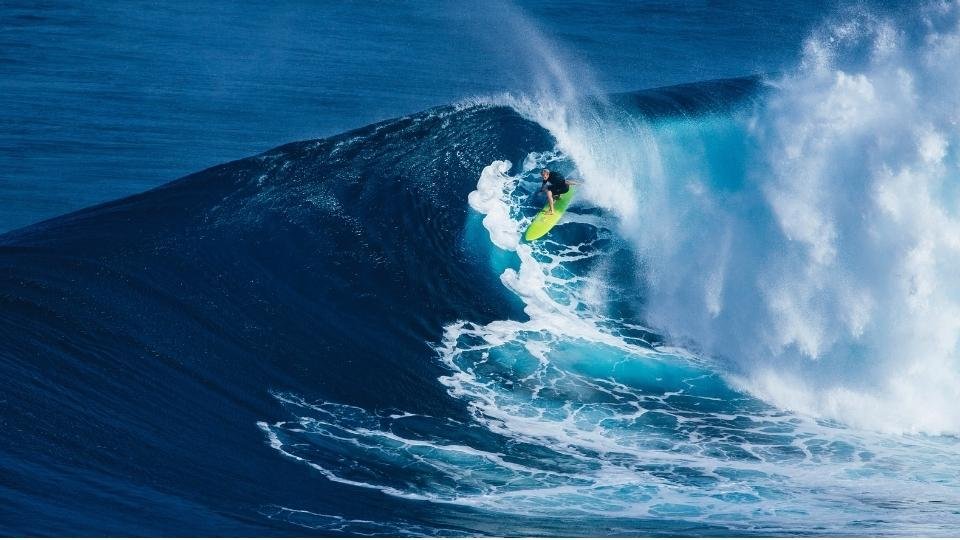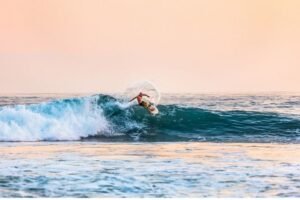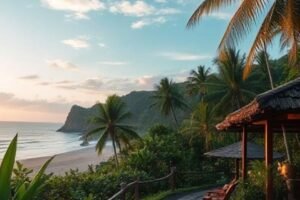
Women Big Wave Surfers. Big wave surfing has long been dominated by men, but over recent years, women big wave surfers have stormed the spotlight. These athletes are proving that the ocean’s most powerful waves are not just for men—they are for anyone with the guts, skill, and determination to face them. This article explores the history, evolution, and achievements of women in big wave surfing, highlighting how they are transforming the sport and inspiring a new generation of fearless women.
Breaking Barriers in Big Wave Surfing
For decades, big wave surfing was seen as an extreme sport reserved for men, where only the strongest and bravest took on the enormous waves of legendary surf spots like Mavericks and Nazaré. However, women surfers have defied expectations and shown the world that they can ride waves just as massive, fast, and powerful as their male counterparts.
One of the most iconic figures in this movement is Maya Gabeira. The Brazilian surfer made headlines when she surfed a 73.5-foot wave at Nazaré, Portugal, earning a Guinness World Record. Her achievements prove that women can surf the biggest waves on Earth and break records doing it.
Another trailblazer, Keala Kennelly, is known for charging waves at Jaws, one of the heaviest breaks on the planet. Kennelly not only competes in some of the world’s most dangerous surf spots but also advocates for gender equality in surfing. Her efforts have inspired countless women to pursue their passion for big wave surfing.
Paige Alms, another key figure, made history by winning the Peʻahi Challenge at Jaws, becoming the first woman to take the top spot at this prestigious event. Alms has proven herself a force to be reckoned with, and her success has opened doors for more women to enter the world of big wave competitions.
The Rise of Women in Big Wave Competitions
Women in big wave surfing face a unique set of challenges, from limited opportunities in elite competitions to lower levels of sponsorship and media coverage. Historically, women were not allowed to participate in many of the top-tier events, but this has changed in recent years.
The Big Wave World Tour now features events for women, including Red Bull Magnitude and the Big Wave Awards, where female surfers are finally getting the recognition they deserve. In 2018, women were allowed to compete in the Mavericks Challenge, a breakthrough moment for gender equality in surfing. These changes mark a new era for women big wave surfers, with more events and more visibility for female athletes than ever before.
The Intense Training of Women Big Wave Surfers
Surviving—and thriving—on big waves requires more than just passion; it demands intense physical and mental preparation. Women big wave surfers undergo rigorous training routines that include strength conditioning, cardio workouts, breath-hold exercises, and mental coaching.
To prepare for the ocean’s wrath, many surfers train their bodies to endure long holds underwater, sometimes for several minutes. They also practice swimming in powerful currents and mastering their fear when the waves crash around them. In addition to physical training, mental preparation plays a critical role. Surfers rely on visualization techniques, breathing exercises, and mindfulness to stay calm in life-or-death situations.
As women continue to push the limits of the sport, they are proving that strength comes in many forms—not just physical, but mental and emotional resilience as well.
Iconic Surf Spots and the History Made There
Some surf spots have become synonymous with big wave surfing, and women have made their mark at each of them:
- Nazaré, Portugal: Known for producing some of the world’s biggest waves, Maya Gabeira made history here by surfing a wave of over 70 feet, setting a Guinness World Record for the largest wave ever ridden by a woman.
- Jaws (Peʻahi), Maui: This notorious break is where Paige Alms made waves by becoming the first woman to win an event at Jaws, solidifying her place in big wave history.
- Mavericks, California: A challenging and often unforgiving surf break, Mavericks was once off-limits to women, but now it’s part of the global conversation, with female surfers pushing the limits at this famous spot.
- Waimea Bay, Hawaii: Considered the birthplace of big wave surfing, Waimea Bay remains a sacred location where female surfers continue to make waves, proving their place in this demanding sport.
Each of these locations has become a stage for women to prove their abilities, and each breakthrough inspires future generations of female surfers to aim higher.
The Community and Sisterhood of Women Surfers
Big wave surfing is an individual sport, but that doesn’t mean women surfers don’t support each other. In fact, there’s a unique sense of camaraderie among women surfers. They encourage one another, share advice, and celebrate each other’s victories.
This sisterhood is important, as it provides a foundation for the growth of the sport among women. Surfers like Justine Dupont, Andrea Moller, and Izzi Gomez actively support each other through social media, mentorship, and collaboration at surf events.
Their mutual respect and collaboration help to break down the barriers that once kept women from the big wave surf scene. They’re not just competitors—they’re allies, pushing each other to be better, braver, and more innovative.
The Challenges Ahead
Despite the progress made, women in big wave surfing still face challenges. Sponsorship deals, prize money, and media exposure are still disproportionately lower than those for their male counterparts. However, as more women rise through the ranks and attract a global following, it’s becoming harder to ignore their contributions to the sport.
There is also a societal shift happening. More young girls are seeing female surfers dominating big wave spots, and they’re becoming inspired to follow in their footsteps. As the surf world becomes more inclusive, it opens doors for future female athletes to make their mark in the sport.
The Future of Women Big Wave Surfers
The future of women big wave surfers looks bright. With the rise of new talent like Moana Jones Wong and Skylar Lickle, it’s clear that the next generation of surfers is already making waves. The sport is on the brink of an exciting new era, where women are no longer a footnote but a headline.
With more opportunities, growing sponsorships, and ever-expanding media coverage, women in big wave surfing are changing the narrative. They are rewriting history with every wave they surf.
Conclusion
Women big wave surfers are no longer an anomaly—they’re a powerful, unstoppable force in the world of surfing. From Maya Gabeira to Keala Kennelly to Paige Alms, these women are making history by surfing the world’s most dangerous waves, breaking records, and proving that there are no limits to what women can achieve. Their achievements will continue to inspire future generations to take on the ocean’s challenges, showing the world that fear and courage can coexist—and that anyone, regardless of gender, can rise to the challenge of big wave surfing.





